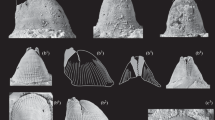Abstract
The monograph on the 500 million-year-oldRehbachiella from the Upper Cambrian ‘Orsten’ of Sweden, published inFossils & Strata 32 by Walossek (1993) comprises a detailed description of its larval sequence and a discussion of functional and comparative aspects of its morphology and ontogeny. A particular attempt was made to clarify the status of Branchiopoda and the phylogenetic position ofRehbachiella as an early branchiopod with particular respect to structural and functional identity of the postmandibular locomotory and feeding apparatus apomorphic to the Branchiopoda. The data provided byRehbachiella and other ‘Orsten’ fossils also aided examination of the ontogenetic patterns of Crustacea and discussion of the morphology and evolution of Crus- tacea.
Similar content being viewed by others
References
Calman, W. T. 1909. Part 7, Appendiculata, 3, Crustacea. In R. Lankester (ed.), A Treatise on Zoology. Adam & Charles Black, London: 1–346.
Chen Jun-Yuan, J. Bergström, M. Lindström & Xianguang Hou, 1991. Fossilized Soft-bodied Fauna. The Chengjiang Fauna — Oldest Soft-bodied Fauna on Earth. National Geographic Research & Exploration 7: 8–19.
Fryer, G., 1983. Functional ontogenetic changes inBranchinecta ferox (Milne-Edwards) (Crustacea, Anostraca). Phil. Trans. r. Soc., Lond. 303: 229–343.
Fryer, G., 1985. Structure and habits of living branchiopod crustaceans and their bearing on the interpretation of fossil forms. Trans. r. Soc., Edinburgh: Earth Sci. 76: 103–113.
Fryer, G., 1987a. Morphology and the classification of the so-called Cladocera. Hydrobiologia 145: 19–28.
Fryer, G., 1987b. A new classification of the branchiopod Crustacea. Zool. J. Linn. Soc.91: 357–383.
Gauld, D. T., 1959. Swimming and Feeding in crustacean larvae: the nauplius larva. Proc. zool. Soc. Lond. 132: 31–50.
Laverack, M. S. & A. Sinclair, 1994. Innervation of the dorsal organ of the shrimpMacrobrachium intermedium (Decapoda: Natantia). J. Crust. Biol. 14: 1–5.
McKenzie, K. G., Chen, Pei-Ji & S. Majoran, 1991.Almatium gusevi (Chernyshev 1940): reproduction, shield-shapes; and speculations on the reproductive mode (Branchiopoda, Kazacharthra). Paläont.Z. 65: 305–317.
Müller, K. J. & D. Walossek, 1985. Skaracarida, a new order of Crustacea from the Upper Cambrian of Västergötland, Sweden. Fossils & Strata 17: 1–65, pls. 1–17.
Müller, K. J. & D. Walossek, 1986a.Martinssonia elongata gen. et sp.n., a crustacean-like euarthropod from the Upper Cambrian of Sweden. Zool. Scripta 15: 73–92.
Müller, K. J/ & D. Walossek, 1986b. Arthropod larvae from the Upper Cambrian of Sweden. Trans. r. Soc., Edinburgh, Earth Sci. 77: 157–179.
Müller, K. J. & D. Walossek, 1987. Morphology, ontogeny, and life-habit ofAgnostus pisiformis (Linnaeus, 1757) from the Upper Cambrian of Sweden. Fossils and Strata 19: 1–124, pls. 1–33.
Müller, K. J. & D. Walossek, 1988. External morphology and larval development of the Upper Cambrian maxillopodBredocaris admirabilis. Fossils and Strata 23: 1–70, pls. 1–16.
Müller, K. J. & D. Walossek, 1991. Ein Blick durch das <Orsten>-Fenster in die Arthropodenwelt vor 500 Millionen Jahren. Verh. Dt. Zool. Ges. 84: 281–294.
Newman, W. A., 1983. Origin of the Maxillopoda; unmalacostracan ontogeny and progenesis. In F. R. Schram (ed.), Crustacean Issues 1, Crustacean Phylogeny. A. A. Balkema, Rotterdam: 105–120.
Nilsson-Cantell, C. A., 1921. Cirripedien-Studien. Zur Kenntnis der Biologie, Anatomie und Systematik dieser Gruppe. Zool. Bidrag, Uppsala 7: 6–395.
Sanders, H. L., 1963. The Cephalocarida. Functional Morphology, Larval Development, Comparative External Anatomy. Mem. Connecticut Acad. Arts & Sci. 15: 1–80.
Schrehardt, A., 1987. A scanning electron-microscope study of the post- embryonic development ofArtemia. In P. Sorgeloos, D. A. Bengston, W. Declair & E. Jaspers (eds.),Artemia Research and its applications. I. Morphology, Genetics, Strain Characterization, Toxicology. Universa Press, Wetteren, Belgium. 5–32.
Walossek, D., 1993. The Upper CambrianRehbachiella and the phylogeny of Branchiopoda and Crustacea. Fossils and Strata 32: 1–202, 54 figs., 34 pls.
Walossek, D. & K. J. Müller, 1990. Stem-lineage crustaceans from the Upper Cambrian of Sweden and their bearing upon the position ofAgnostus. Lethaia 23: 409–427.
Walossek, D. & K. J. Müller, 1992. The ‘alum shale window’-contribution of ‘Orsten’ arthropods to phylogeny of Crustacea. Acta Zool. 73: 305–312.
Walossek, D. & K. J. Müller, 1994. Pentastomida from the Lower Palaeozoic of Sweden. Trans. r. Soc., Edinburgh, Earth Sci. 85: 1–37.
Weisz, P. B., 1946. The space-time pattern of segment formation inArtemia salina. Biol. Bull. 91: 119–140.
Weisz, P. B., 1947. The histological pattern of metameric development inArtemia salina. J. Morphol. 81: 45–95.
Author information
Authors and Affiliations
Rights and permissions
About this article
Cite this article
Waloßek, D. The Upper CambrianRehbachiella, its larval development, morphology and significance for the phylogeny of Branchiopoda and Crustacea. Hydrobiologia 298, 1–13 (1995). https://doi.org/10.1007/BF00033797
Issue Date:
DOI: https://doi.org/10.1007/BF00033797




